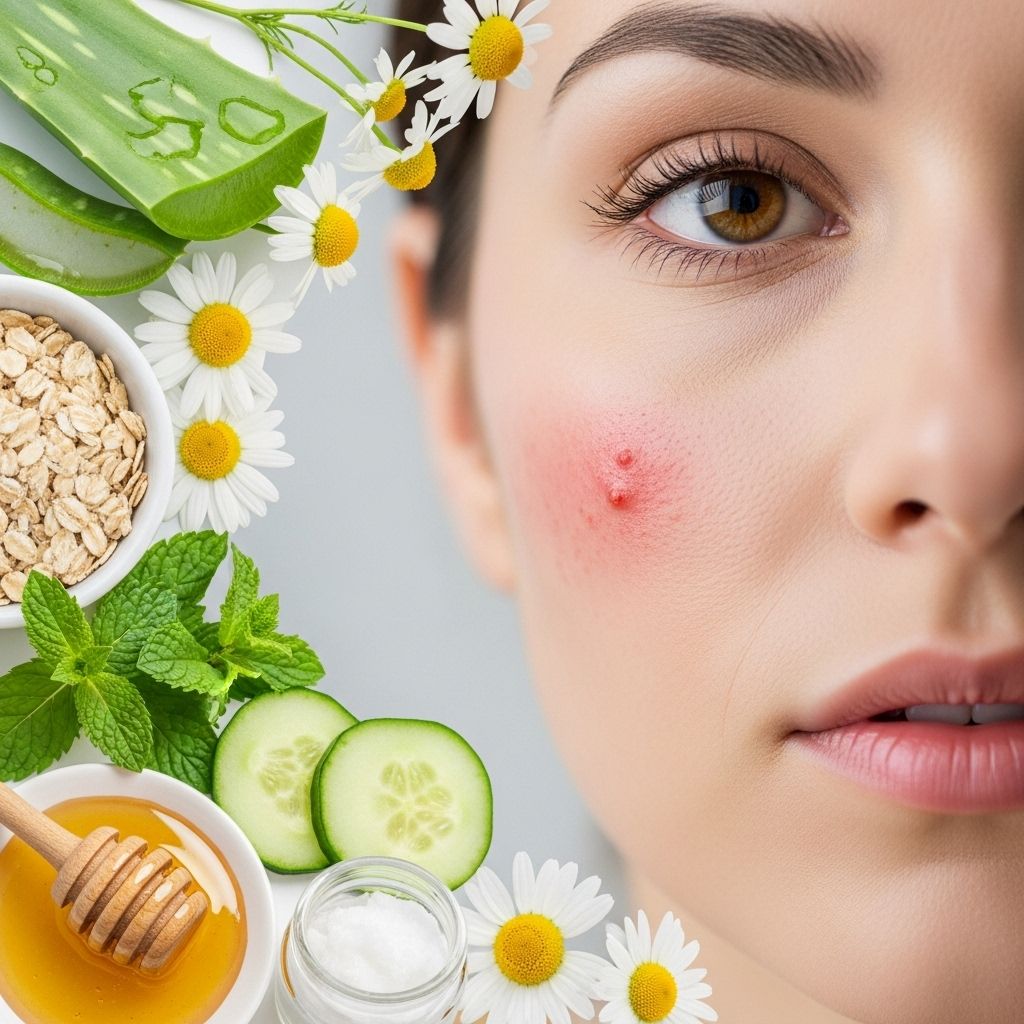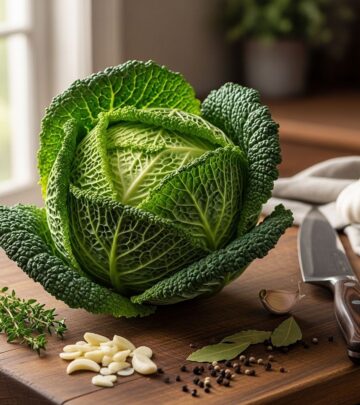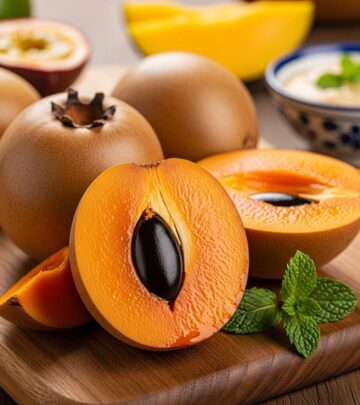22 Home Remedies to Soothe and Relieve Facial Skin Rashes
Gentle pantry staples and oils soothe redness, reduce itch, and support skin recovery.

Facial skin rashes are common and can result from allergies, irritants, infections, climate changes, or underlying health issues. While medical care may be needed for severe or persistent rashes, many mild skin irritations can be relieved with safe, natural remedies that soothe, hydrate, and protect your skin. Below you’ll find 22 effective home remedies for combatting facial rashes, their benefits, how to use them, and important precautionary tips. Always conduct a patch test and consult a dermatologist if your rash is severe, spreading, or accompanied by systemic symptoms.
Key Takeaways
- Natural remedies like aloe vera, honey, oatmeal, cucumber, and tea tree oil may reduce rash symptoms with minimal side effects.
- Cucumber soothes and decreases swelling and tenderness, while tea tree oil combats bacteria and fungi.
- Hydration and avoidance of harsh chemicals protect face skin from further irritation.
- Seek medical attention if rashes persist, worsen, or spread rapidly.
Home Remedies For Skin Rashes
1. Essential Oils
Essential oils such as tea tree, lavender, chamomile, and rosemary possess antimicrobial and anti-inflammatory properties. They help calm itchy skin, reduce redness, and support healing—but must always be diluted in a carrier oil.
- You Will Need: 2–3 drops essential oil, 1 tbsp carrier oil (e.g., coconut, jojoba).
- How to Use: Mix and apply to affected area, leave for 30 minutes, rinse. Use once daily. Patch test recommended.
2. Apple Cider Vinegar
Apple cider vinegar has both anti-inflammatory and antimicrobial effects. It may help relieve rash symptoms, though scientific evidence remains limited.
- You Will Need: 1 tbsp apple cider vinegar, ½ cup water, cotton pad.
- How to Use: Dilute vinegar in water, soak pad, apply to rash. Let dry completely. Repeat twice daily.
- Some users, like beauty blogger Zoe, report toner-like relief of rash symptoms.
3. Coconut Oil
Coconut oil offers anti-inflammatory, antimicrobial, and analgesic benefits and is especially effective for dry, irritated, or acne-prone facial skin.
- You Will Need: Virgin coconut oil.
- How to Use: Gently massage a small amount onto the rash. Leave for 30–60 minutes; may also be left overnight. Rinse. Use daily.
4. Baking Soda
Baking soda may help neutralize skin pH and reduce itching (antipruritic), although evidence is limited.
- You Will Need: 1 tsp baking soda, water.
- How to Use: Mix into a paste, apply to rash, let dry, rinse with water.
- Caution: Always patch test on a small area first.
5. Aloe Vera
Aloe vera gel is deeply soothing, anti-inflammatory, and antimicrobial. Its bioactive compounds help reduce redness, swelling, and support healing.
- You Will Need: Fresh aloe vera gel.
- How to Use: Apply gel directly to rash, leave for 30+ minutes, rinse. Repeat 1–2 times daily.
6. Epsom Salt
Epsom salt has calming and anti-inflammatory properties. For facial use, avoid robust exfoliation and use gentle solutions.
- You Will Need: 1 tsp Epsom salt, ½ cup water.
- How to Use: Dissolve salt, soak cotton pad, apply gently to affected area. Rinse after 10 min.
7. Petroleum Jelly
Plain petroleum jelly forms a protective barrier, helps retain moisture, and soothes irritation, especially for dry or chafed skin.
- You Will Need: Petroleum jelly.
- How to Use: Apply a thin layer to rash to seal in moisture.
8. Castor Oil
Castor oil is rich in fatty acids and provides relief from irritation. Its anti-inflammatory properties may help reduce swelling.
- You Will Need: Castor oil.
- How to Use: Dab lightly onto the rash area. Leave for 15–30 min, rinse.
9. Breast Milk
For babies or adults nursing, breast milk contains antibodies and growth factors that may help soothe and heal mild facial rashes, especially in infants.
- How to Use: Dab a small amount on rash, let dry naturally.
10. Hydrogen Peroxide
Hydrogen peroxide is a disinfectant that helps prevent infection and dry oozing rashes, but can be harsh. Use with caution and only on intact skin.
- How to Use: Dilute with water, dab on rash (not open wounds).
11. Manuka Honey
Manuka honey is famed for its antimicrobial, anti-inflammatory, and skin-repairing properties. Promotes healing and soothes irritation.
- You Will Need: Pure manuka honey.
- How to Use: Apply thin layer to affected area, leave for 30 min, rinse.
12. Green Tea
Green tea has anti-oxidants and polyphenols that help calm inflamed skin.
- You Will Need: Brewed cooled green tea.
- How to Use: Soak cotton pad in tea, apply as a toner. May repeat twice daily.
13. Neem Oil
Neem oil has potent antibacterial, antifungal, and anti-inflammatory properties. Useful for treating rashes caused by infection.
- How to Use: Mix a few drops into a carrier oil, apply to rash, leave for 30 min. Rinse.
14. Lemon Juice
Lemon juice is astringent and antibacterial but may be too harsh for sensitive skin. Useful for oily or infected areas. Always patch test.
- You Will Need: Fresh lemon juice, water.
- How to Use: Dilute juice, dab gently, leave for 5 min, rinse.
15. Oatmeal
Oatmeal is a classic remedy for soothing itchy, inflamed skin. It is hydrating and forms a protective barrier, making it ideal for gentle facial care.
- You Will Need: Colloidal oatmeal.
- How to Use: Mix with water into a paste, apply as face mask for 20–30 min. Rinse.
16. Garlic
Garlic contains sulfur compounds that are antimicrobial and anti-inflammatory. Use only on intact skin and avoid if you have sensitive skin.
- You Will Need: Crushed garlic, carrier oil.
- How to Use: Mix, gently apply, rinse after 10 minutes.
17. Ginger
Ginger’s anti-inflammatory compounds may help calm irritated skin. Use the juice diluted in water.
- You Will Need: Fresh ginger juice, water.
- How to Use: Dab gently, leave for 10 min, rinse.
18. Grapefruit Seed Extract
Grapefruit seed extract acts as a natural antiseptic, helpful for microbial rashes. Always dilute before applying.
- How to Use: Mix a few drops with water, apply with cotton pad, rinse after 5 min.
19. Jojoba Oil
Jojoba oil is noncomedogenic and closely mimics skin’s natural sebum, making it ideal for hydrating and soothing rash-prone skin.
- How to Use: Apply several drops, leave overnight. Rinse as needed.
20. Onion Juice
Onion juice is rich in flavonoids and sulfur, with strong anti-inflammatory effects. Use with carrier oil for rash relief.
- How to Use: Mix juice with carrier oil, apply and leave for 15 min. Rinse.
21. Carrot Juice
Beta-carotene and antioxidants in carrot juice promote healing and reduce inflammation. Use as a topical compress.
- You Will Need: Fresh carrot juice, clean cloth.
- How to Use: Soak cloth, place on rash for 10 min, rinse.
22. Humidifiers
Using a humidifier adds moisture to the air, which can help prevent skin from drying and developing rashes, especially in cold or arid environments.
- Place a humidifier in your room for continuous relief from dryness and rash triggers.
Preventive and Lifestyle Tips
In addition to these remedies, follow these skin-friendly habits to minimize the risk and severity of facial skin rashes:
- Drink plenty of water to maintain skin hydration.
- Avoid harsh chemical products and fragrances.
- Change pillowcases and towels frequently to reduce bacteria and fungus.
- Limit direct sun exposure. Use non-comedogenic sunscreen.
- Practice gentle cleansing routines—avoid scrubbing or overwashing.
- Use hypoallergenic skincare and avoid triggers if identified (e.g., specific foods, dust, fabrics).
- Consult your doctor for unexplained, spreading, or painful rashes.
Comparison of Key Remedies
| Remedy | Main Benefit | Caution |
|---|---|---|
| Aloe Vera | Soothes, heals, antimicrobial | Rare allergies |
| Oatmeal | Moisturizes, protects, calms | Messy, rare allergy |
| Coconut Oil | Hydrates, anti-inflammatory | Pore clogging for oily skin |
| Baking Soda | Reduces itch, balances pH | Can be drying, patch test mandatory |
| Tea Tree Oil | Antimicrobial, prevents infection | Always dilute, possible irritation |
| Lemon Juice | Antibacterial, astringent | Harsh, patch test essential |
| Petroleum Jelly | Moisure seal, protection | Not for infected rashes |
Frequently Asked Questions (FAQs)
Q: Are home remedies safe for all types of facial rashes?
Most remedies discussed are safe for mild, non-infectious rashes. For severe, spreading, or oozing rashes—or if you have underlying health conditions—always consult with a healthcare provider first.
Q: How quickly do these remedies relieve rash symptoms?
Many remedies provide immediate soothing—such as cold compress, aloe vera, oatmeal, and coconut oil—but full relief and healing can take a few days. If symptoms persist, worsen, or spread, seek medical attention.
Q: Can these remedies prevent future rashes?
Using gentle moisturizers (like coconut oil, oatmeal), maintaining hydration, and avoiding triggers (allergens, irritants) may help prevent recurrence of facial rashes.
Q: What should I do if a remedy causes burning or worsening symptoms?
Immediately discontinue the remedy, rinse the area, and consult a dermatologist. Mild redness may be normal, but increasing pain, swelling, or blistering suggest allergic reaction or incompatibility.
Q: When should professional medical care be sought?
Seek professional help if rashes:
- Are accompanied by fever, systemic illness, or pain.
- Do not improve with home care.
- Spread rapidly or form blisters.
- Occur in infants, elderly, or immunocompromised individuals.
Final Thoughts
Facial rashes can be uncomfortable—but gentle, natural remedies and healthy skincare practices can offer significant relief for many common causes. Remember to consult a medical professional for any severe or unexplained symptoms, and prioritize skin health by avoiding harsh chemicals, maintaining hydration, and using only products suited for your skin type.
References
- https://www.healthline.com/health/home-remedies-for-rashes
- https://www.stylecraze.com/articles/home-remedies-to-treat-rashes-on-the-face/
- https://docsmedicalgroup.com/docsurgentcare/10-effective-home-remedies-for-heat-rashes-when-to-seek-help-from-urgent-care-in-southington-ct/
- https://www.stylecraze.com/articles/dry-skin-around-mouth/
- https://www.youtube.com/stylecraze
- https://www.medicalnewstoday.com/articles/324228
- https://www.columbiadoctors.org/health-library/article/skin-rashes-home-treatment/
Read full bio of Sneha Tete












